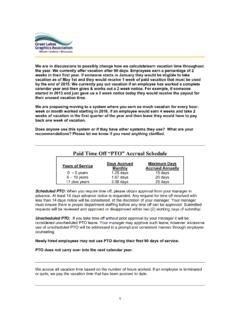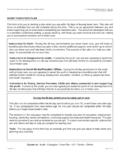Transcription of For a Senior Executive Taking Charge in a New Role, It's ...
1 Senior Executive Transitions: Managing the Three Waves of Change Page 1 of 41 Copyright 2014 Gary Myszkowski All Rights Reserved For a Senior Executive Taking Charge in a New Role, It's About the Changes Beyond the first 90 - 100 days : Managing the Three Waves of Change During the Transition Gary J. Myszkowski, Senior Consultant, Executive Coach, and Talent Management Executive Executive Core February 2014 Senior Executive Transitions: Managing the Three Waves of Change Page 2 of 41 Copyright 2014 Gary Myszkowski All Rights Reserved Transition Example: Reawakening an Organization Resting on Past Laurels When Carol Crost had been promoted to CEO from within this multinational technology company, she was the President of one of the independent divisions.
2 Having some familiarity with the other divisions and executives at the corporate headquarters, she entered the corporate CEO job expecting to complete her evaluation of the portfolio of businesses and major projects, finalize her team, and begin to implement business performance improvement plans within the first six months. The previous CEO had been directed by the Board to stabilize the many businesses that had been disrupted by the most recent major global recession and reduce all unnecessary costs. In contrast, Carol was now expected to initiate an era of renewed growth. In the first few months, Carol identified several technology development projects that seemed to be languishing and required exit strategies.
3 There weren't any. She also discovered that the American Executive assigned to build new alliances in Asia, a key element of the growth strategy, had made little progress, was not respected by potential Asian alliance decision-makers, and needed to be replaced with someone local with pre-existing credibility and long-term relationships. She made some changes. These were some early wins she could show to the Board as she broadened her span of attention to grow other parts of the portfolio of businesses. After four months on the job, Carol tried to accelerate several of the key new technology development projects and reduce the time and resources it was Taking to get through the Stage Gate Reviews.
4 She wanted to get something across the finish line. She discovered that few managers shared her sense of urgency. Managers were more committed to following past practices and procedures than finding ways to speed up the processes, still meet the purposes of the reviews, and get to outcomes. Others seemed adept at playing the negotiating game of "I am going to 'low ball' when I can actually accomplish the next steps because you are just going to come back later and ask me to do it faster anyway." There seemed to be 50 reasons for "why we can't change." The resistance was stronger, seemed to permeate multiple levels of management, and she was losing trust in the capabilities of some of her Executive team to see the business for what it was, "warts and all.
5 " Unfortunately, these were the changes that she assumed would be the easier ones. Carol did not have a lot of answers. How would she manage the Board's expectations at the next meeting in two weeks? 40+% of Senior -level Executive external hires and internal promotions will fail to achieve their objectives within the first 18 months of their transitions. Senior Executive Transitions: Managing the Three Waves of Change Page 3 of 41 Copyright 2014 Gary Myszkowski All Rights Reserved After two decades studying over 4,000 newly placed and promoted Senior executives around the world, this story has become a familiar one. If you work for a company or organization that helps people onboard once they ve been promoted or newly hired, chances are you ve heard how important the first 90 to 100 days are.
6 Most companies have spent millions of dollars focusing on just a few weeks after a person takes the reins of a new position assuming that period is the best predictor of success. However, the body of research on successful onboarding of Senior executives requires us to think longer term. It takes most leaders almost three years to integrate into a new role, make important improvements, and then see the results of their efforts. In a world that is becoming more impatient too focused on superficial quick fixes successful onboarding can best be assured by how well a leader navigates through three predictable "waves of change" during the transition. Whether you are a newly promoted or externally recruited Executive , or someone who helps onboard executives, there is much we can do to better anticipate the typical three waves of change that are intertwined with executives' learning during these transitions.
7 Too many organizations let their most precious Executive resources sink or swim during transitions. It is a waste to have people relearning the same lessons over and over again. Organizations can cost-effectively accelerate all Senior Executive transitions by institutionalizing a common model and set of tools. And the organizations that do invest in onboarding activities will discover that Taking a slightly longer time perspective will protect their investment in high potential Executive talent. Taking Charge : It's Beyond the first 90 - 100 days Senior executives with P&L responsibility or serving as the head of a key functional area will need approximately five quarters to fully analyze and learn about the situation of their new assignment, finalize their team, and develop an effective plan to improve the organization's or businesses' performance.
8 Most will think they can accomplish all of this in the first four to six months of their tenure when they start their new assignment. They will be disappointed! It may be an additional eighteen months to two years before the business achieves the sustainable, consistent business outcomes that are a result of the Executive (and his or her team) having successfully taken Charge and essentially mastered the circumstances of the business. In the process, the Executive and his or her Senior Executive Transitions: Managing the Three Waves of Change Page 4 of 41 Copyright 2014 Gary Myszkowski All Rights Reserved team will have learned from leading three sequential iterations of organizational change.
9 For roles with the authority, discretionary decision-making, and accountability for a significant part of the business or the entire business or brand, effectively managing these three waves of change is an almost inescapable requirement for a successful transition. While the transitions of CEOs can be a special case among Senior Executive roles, conclusions from recent research support Taking a longer view of Senior Executive transitions. From their research on the factors influencing the effectiveness of promoting insider and onboarding "outsider" CEOs, Karaevli and Zajac 1 recommend that Boards of Directors implement well-managed transition processes particularly for outsider CEOs, allow them the time to truly evaluate the business and build support, while striking the right balance between immediate results and fundamental changes.
10 Karaevli and Zajac conclude, "With so much emphasis on a newcomer s ' first 100 days in office,' it s easy to forget that outsiders are usually brought in for cultural change which takes much longer." As we will show, previous research indicates this is also true for internal promotions to key Executive roles. Necessary but Not Sufficient Successfully navigating the first 90 to 100 days of transition into a new Executive role is "necessary but not sufficient" for a Senior Executive to take Charge of the new responsibilities and begin to achieve her or his business objectives. The focus on the first 90 to 100 days may be sufficient for successful transitions into supervisory and management jobs with limited discretionary decision-making and focused more on a defined set of processes and tasks.









